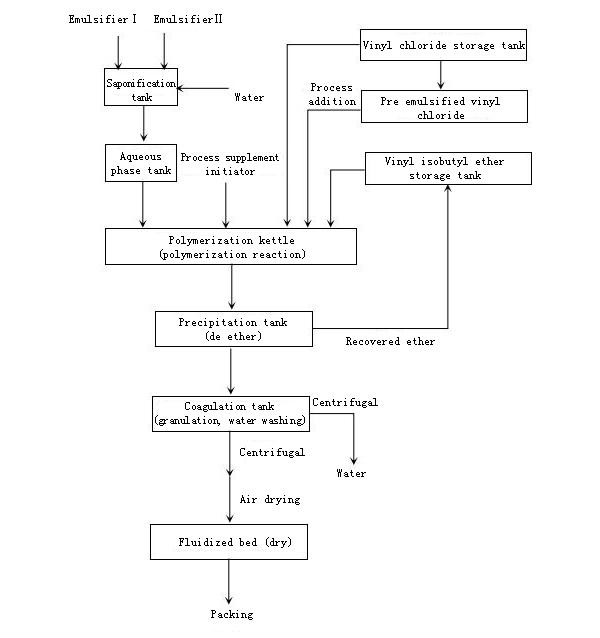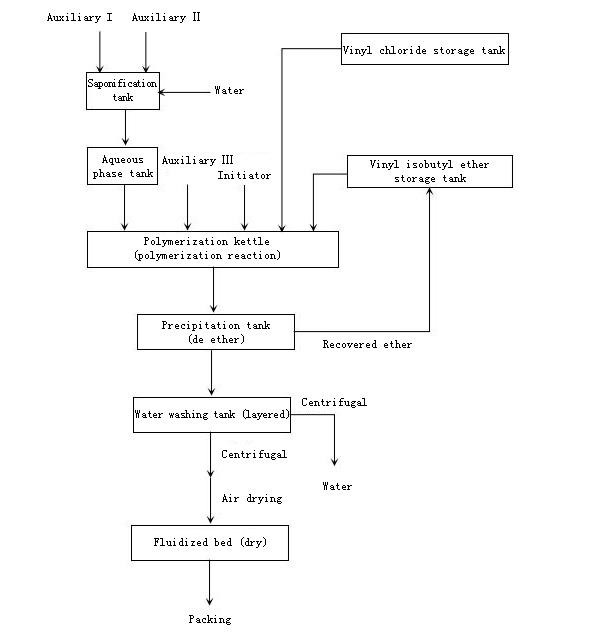1、 Overview
1. Production: chlorinated polymers are widely used because of their excellent corrosion resistance. Chlorinated rubber occupies a large proportion in chlorinated polymers because of its excellent corrosion resistance. In recent years, the requirements of environmental protection regulations are becoming more and more strict. Traditional chlorinated rubber is limited by countries because it contains more residual CCl4 and pollutes the atmosphere. According to the provisions of the Montreal Protocol, developed countries have successively shut down the production of chlorinated rubber with carbon tetrachloride since 1995, allowing a grace period of 10 years for developing countries, that is, stopping the use of carbon tetrachloride by 2005 (i.e. from January 1, 2006). As a base material for heavy-duty anti-corrosion coatings instead of chlorinated rubber, Chloroether resin has a very broad application prospect because of its superior price and environmental protection advantages. BASF company first launched this product and did a lot of application research.
2. Structure: vinyl chloride resin is a copolymer of 75% vinyl chloride (VC) and 25% vinyl isobutyl ether (IBVE).

3. Characteristics:
(1) Good solubility: aromatics, esters, glycol ethers and their esters and ketones are the real solvents of Chloroether resin, which can be dissolved by stirring in the real solvent.
(2) Good corrosion resistance: the Chloroether resin molecule does not contain saponifiable ester bond, and has good acid resistance, alkali resistance and salt resistance. It has wide miscibility with other resins for coating, which can improve the performance of other resins (such as alkyd resin, asphalt, etc.).
(3) Good stability: there is no reactive double bond in the molecule of Chloroether resin, which is not easy to be degraded by atmospheric oxidation; Excellent light stability, not easy to yellowing and pulverization.
(4) Good adhesion: Chloroether resin contains copolymerized vinyl isobutyl ether, which is easy to form hydrogen bond with the substrate to ensure good adhesion of the coating on various substrates.
(5) Good internal plasticity: isobutyl ether exists as a branch of the polymer chain in the molecular structure of Chloroether resin, so that its polymer molecules are not easy to stack tightly and the crystallinity is reduced. The macro performance is that the flexibility of the polymer is enhanced and has good internal plasticity. It has sufficient flexibility without adding plasticizer. In this way, the content of plasticizer in the formula can be controlled very low, and the hardness of the film will not be reduced due to the migration of excessive plasticizer, resulting in embrittlement, cracking and falling off.
(6) Good compatibility: Chloroether resin is very soluble with other resins, and can improve and improve the performance of coatings based on dry oil, alkyd resin, tar and asphalt, epoxy and acrylic acid.
(7) Good flame retardancy: Chloroether resin contains chlorine atoms and has certain flame retardancy. By adding other flame retardant pigments, fillers and fire retardants, it can be made into fire retardant coatings, which can be used in the field of building fire prevention.
2�、 Products
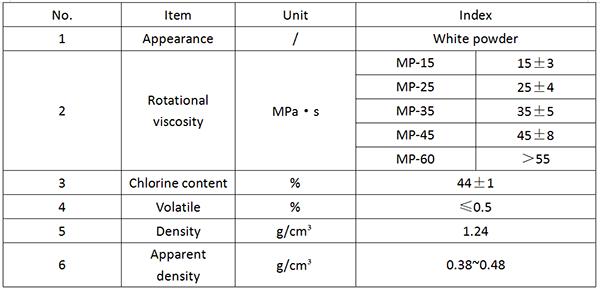
The rotational viscosity is measured with a rotameter in 20% toluene solution at 23 ℃ according to iso3219.
3��、 Synthetic process
1. Emulsion Polymerization -- BASF company
flow chart:
2. Suspension polymerization - Huitong company
flow chart:
3. the main differences between emulsion polymerization and suspension polymerization are:
 4�����、 Apply
4�����、 Apply
1. Coating
(1) Composition
① Solvent: Chloroether resin is insoluble in aliphatic hydrocarbon and alcohol solvents. They can only be used as diluent and can be dissolved in aromatic hydrocarbon, chlorinated hydrocarbon, ester, ethylene glycol ether and its ester and ketone solvents. Glycol ethers will reduce the water resistance of the film, and ketones are easy to remain in the film. The commonly used solvents are xylene, butyl acetate, high boiling aromatic solvents, etc., and xylene is the most commonly used.
② Plasticizer: mainly chlorinated paraffin, phthalate, adipate and phosphate are rarely used because they are easy to hydrolyze. Plasticized resins such as urea, polyester, acrylic acid and epoxy are also often used.
③ Pigments and fillers: the same as usual coatings.
④ Additives: dispersant, defoamer, leveling agent, etc.
⑤ Anti sedimentation agent: organic bentonite, fumed silica, hydrogenated castor oil, etc.
⑥ Heat stabilizer: low molecular epoxy resin, organotin stabilizer, etc. Generally, the Chloroether resin itself has sufficient anti chlorination stability, and no stabilizer is required in the formula. If the coating of Chloroether resin coating needs to be continuously exposed to an environment higher than 70 ℃ for a long time, a heat stabilizer must be added in the formula.
(2) Domain
① Industrial anti-corrosion coating: Chloroether resin alone or in combination with alkyd resin, acrylic resin or epoxy resin, and antirust pigment or zinc powder make bottom or surface coating. It is widely used in the anti-corrosion of steel components such as external pipelines and storage tanks of factories, steel components in chemical industry, and buildings in contact with water and steam, so as to prevent corrosion caused by industrial atmosphere. Reference formula for epoxy high build primer:
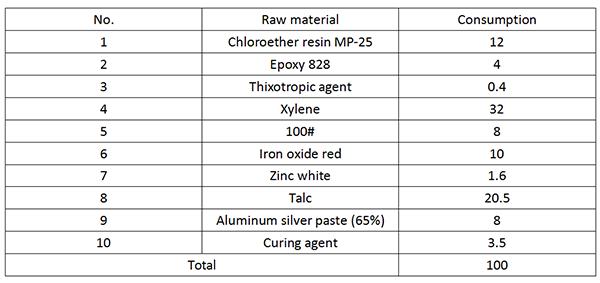
② Ship coating: Chloroether resin is mixed with asphalt, cuprous oxide, iron red and hydrocarbons containing bromine and iodine. After immersion in seawater, only 5% of the steel plate is adhered by marine organisms; After adding zinc oxide and phenylphenol, the coating has good stain resistance, and the coating is still not contaminated after soaking in seawater for two years.
Antifouling paint reference formula:
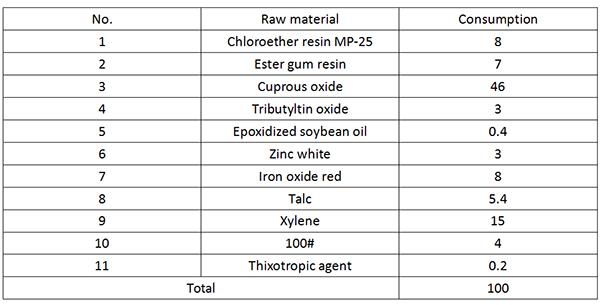
③ Container coating: in order to ensure the quality of container coating, the International Committee for container standardization has unified regulations on the identification and testing of container coating, that is, the coating system must pass 8 projects and 13 methods of konstandt lab in the United States, and obtain the Laboratory Approval Certificate (with a total score of more than 120) before it can be used on the container. Chloroether resin coating is used in the field of container because of its excellent adhesion and water resistance, and can ensure the stability of the coating within the range of large temperature change. At present, most companies use Chloroether resin to make coatings, send samples for testing, and then use acrylic resin to make coatings for production and use.
Container finish reference formula:
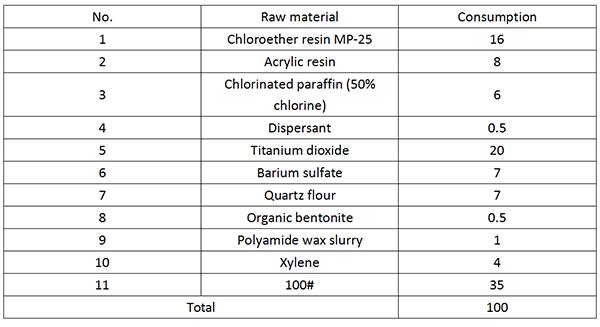
④ Light metal primer and finish: as the Chloroether resin contains copolymerized vinyl isobutyl ether bond, it can ensure good adhesion on the surface of aluminum, zinc, galvanized steel and other substrates, which can not be compared with other chlorinated olefin resin coatings. It can be used in garage doors and windows, roof gutters, balconies, lamp posts and highway anti-collision isolation plates.
Aluminum zinc yellow primer reference formula:
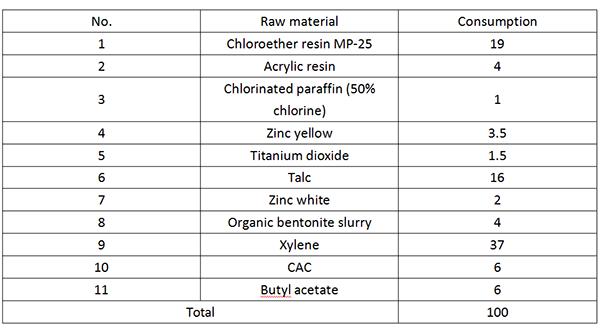
⑤ Plastic coating: it is generally mixed with acrylic resin to make coating on polyester, rigid polyvinyl chloride, nylon, polystyrene, phenolic, melamine and other plastic substrates.
⑥ Inorganic substrate coating: it is made of Chloroether resin and alkali resistant plasticizer. It can be used for asbestos, cement, concrete, masonry and other alkaline substrates to prepare swimming pool coating, architectural coating, bridge coating and road sign coating.
Sky blue swimming pool paint reference formula:
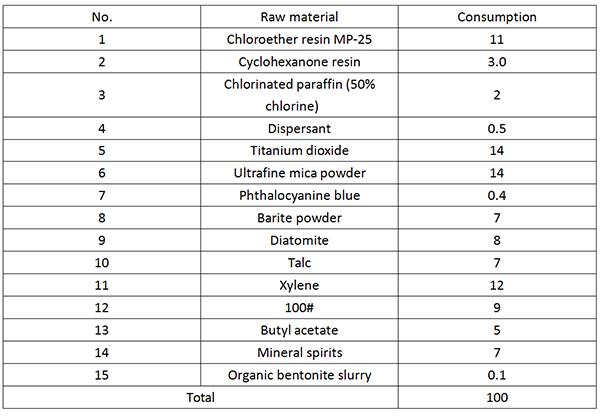
⑦ Wood coatings, paper coatings, flame retardant coatings, etc.
2. Ink
(1) Composition
① Solvent: ethyl acetate is mainly used now. From the perspective of environmental protection, benzene and ketone are not used.
② Supporting resin: EVA resin, CPP resin, etc.
③ Pigments: titanium dioxide, phthalocyanine blue, YONGGU red and other common pigments.
④ Additives: dispersant, defoamer, leveling agent, antioxidant, antistatic agent, etc.
(2) Field: plastic gravure composite ink, used in OPP, CPP, mixed PE and other flexible packaging.
(3) Characteristics
① Excellent printing adaptability, can adapt to all kinds of gravure printing machines, especially suitable for low viscosity and high-speed printing.
② Three color overprint has bright color, clear layers and good dot reproducibility.
③ For different composite materials, it can provide excellent composite strength.
④ Good ink transfer, not easy to dye.
⑤ The residue of ink solvent is very little, which is suitable for the requirements of food packaging.
5����、 Comparison with other chlorinated polymer coatings
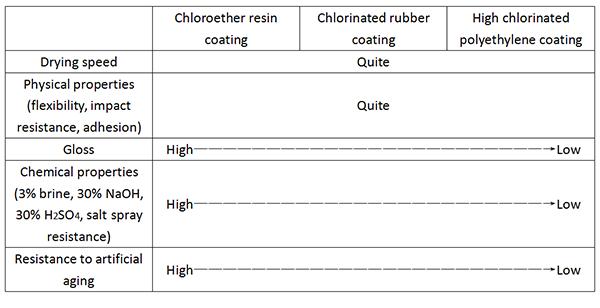 Reference
[1] Bai junqian, production, application and development prospect of Chloroether resin, Tianjin chemical industry, September 2011, Volume 25, issue 25, 5-7
[2] Wang Tong, overview of production and application of Chloroether resin, Shanghai chlor alkali chemical industry, 2005, issue 3, 22-27
[3] Zhu Xueshan, properties and specific applications of vinyl chloride and isobutyl vinyl ether copolymer resin, Zhejiang chemical industry, 2005, Vol. 36, No. 5, 20-21
[4] Liu Songtao, emulsion polymerization of vinyl chloride / vinyl isobutyl ether copolymer, chlor alkali China, eleventh issue 9-11 in 2010
[5] Xu Chunrong, development of modified Chloroether resin coating, modern coating and coating, August 2011, Volume 14, issue 8, 36-40
[6] Jiang Juan, Cheng hailing, Zhu Jie, application of Chloroether resin in coatings, Shanghai coatings, Vol. 48, No. 8, 2010, 53-55
Reference
[1] Bai junqian, production, application and development prospect of Chloroether resin, Tianjin chemical industry, September 2011, Volume 25, issue 25, 5-7
[2] Wang Tong, overview of production and application of Chloroether resin, Shanghai chlor alkali chemical industry, 2005, issue 3, 22-27
[3] Zhu Xueshan, properties and specific applications of vinyl chloride and isobutyl vinyl ether copolymer resin, Zhejiang chemical industry, 2005, Vol. 36, No. 5, 20-21
[4] Liu Songtao, emulsion polymerization of vinyl chloride / vinyl isobutyl ether copolymer, chlor alkali China, eleventh issue 9-11 in 2010
[5] Xu Chunrong, development of modified Chloroether resin coating, modern coating and coating, August 2011, Volume 14, issue 8, 36-40
[6] Jiang Juan, Cheng hailing, Zhu Jie, application of Chloroether resin in coatings, Shanghai coatings, Vol. 48, No. 8, 2010, 53-55




